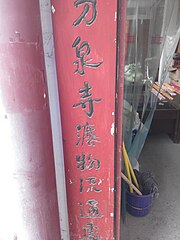Zhuodaoquan Temple
| Zhuodaoquan Temple | |
|---|---|
卓刀泉寺 | |
| Country | China |
| Architecture | |
| Style | Chinese architecture |
Zhuodaoquan Temple (
History
According to a story passed down at the temple and recorded in part in the 寰宇通志 (Huányǔ Tōngzhì) written in 1455 and the late Qing 江夏縣志 (Jiāngxià Xiànzhì), in the year AD 208, as Guan Yu passed through the area, his troops and their horses were thirsty. In a fit of anger, Guan Yu thrust his sword into a rock (卓刀, zhuódāo). This opened up a spring which provided water for his troops and their horses to drink. Zhuodaoquan Temple takes its name from this story.[2] Their horses were kept at nearby Mount Mafang (馬房山, "Horse Stable Mountain") on the present-day campus of the Wuhan University of Technology.[3]
The temple was built during the
During the
In 1916, the temple was renovated in the style of Siheyuan and included statues of Liu Bei, Guan Yu, and Zhang Fei.[2]
The temple was used as a headquarters for military operations during the Northern Expedition.[1]
In 1956, the temple was repaired by the Wuhan City government. In 1959, the temple was recognized as an important cultural heritage site.[1]
The temple and statues were damaged during the Cultural Revolution.[1] The temple was reopened in 1988.[2]
In 2010,
Gallery
-
Well of Zhuodao Spring (Zhuodao Quan)
-
Introduction to Ancient Zhuodaoquan Temple
-
Zhuodaoquan Temple Religious Materials Sales
References
- ^ a b c d e 武汉卓刀泉寺:忠义降魔关公显圣. 人民网_网上的人民日报 (in Chinese). 9 May 2014. Retrieved 2 November 2018.
1991年落实宗教政策,寺院交与佛教,并进行了修缮。
- ^ a b c d e f 关公卓刀为泉传说入选国家级非遗 已流传1800多年. 人民网_网上的人民日报 (in Chinese). 5 December 2014. Retrieved 2 November 2018.
- ^ 伏虎山,一座与关羽密切关联的城中山. 长江商报官方网站 (in Chinese). 21 September 2015.
马房山和桂子山相连,和珞珈山、伏虎山同属一脉。位于武汉理工大学马房山校区的桂竹园,是马房山的最高处。



